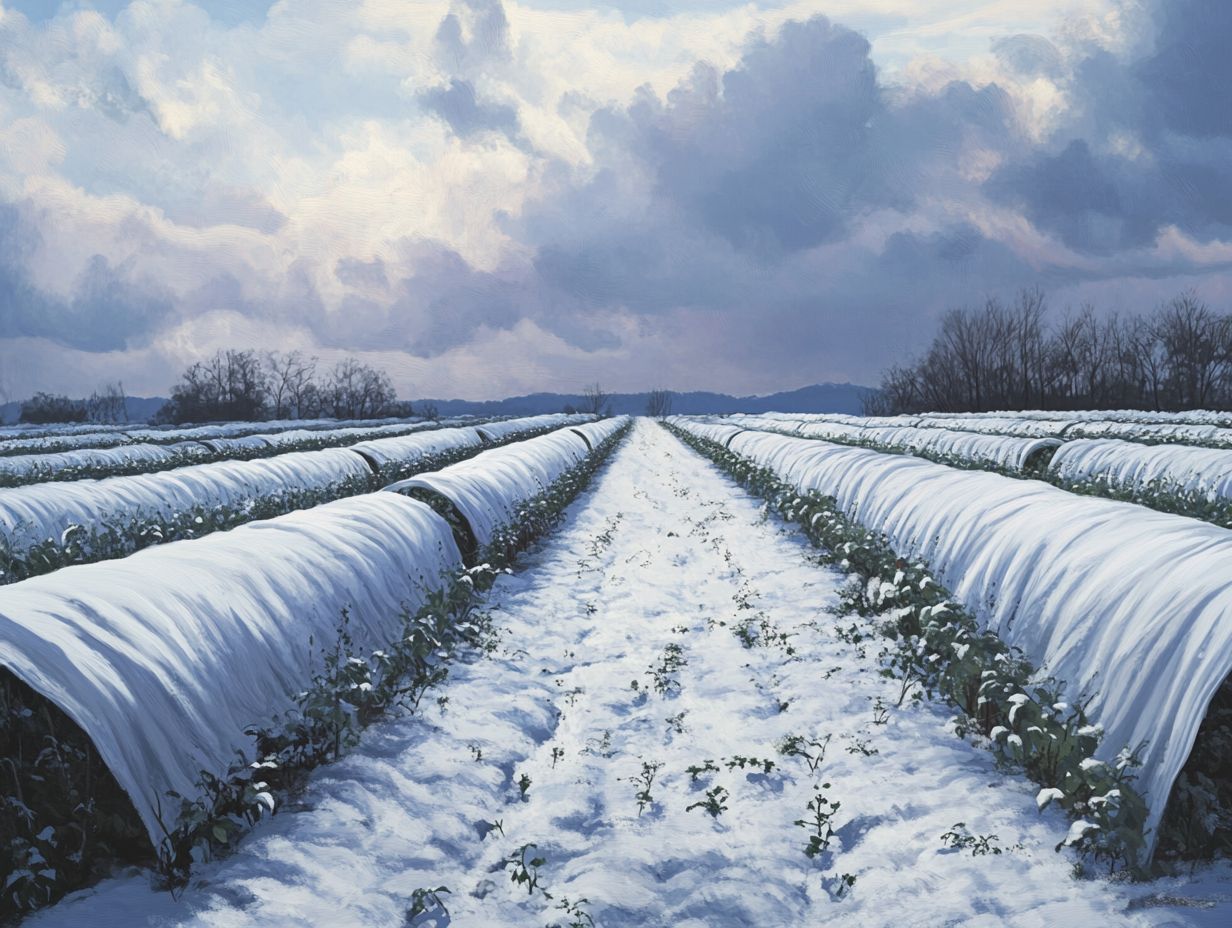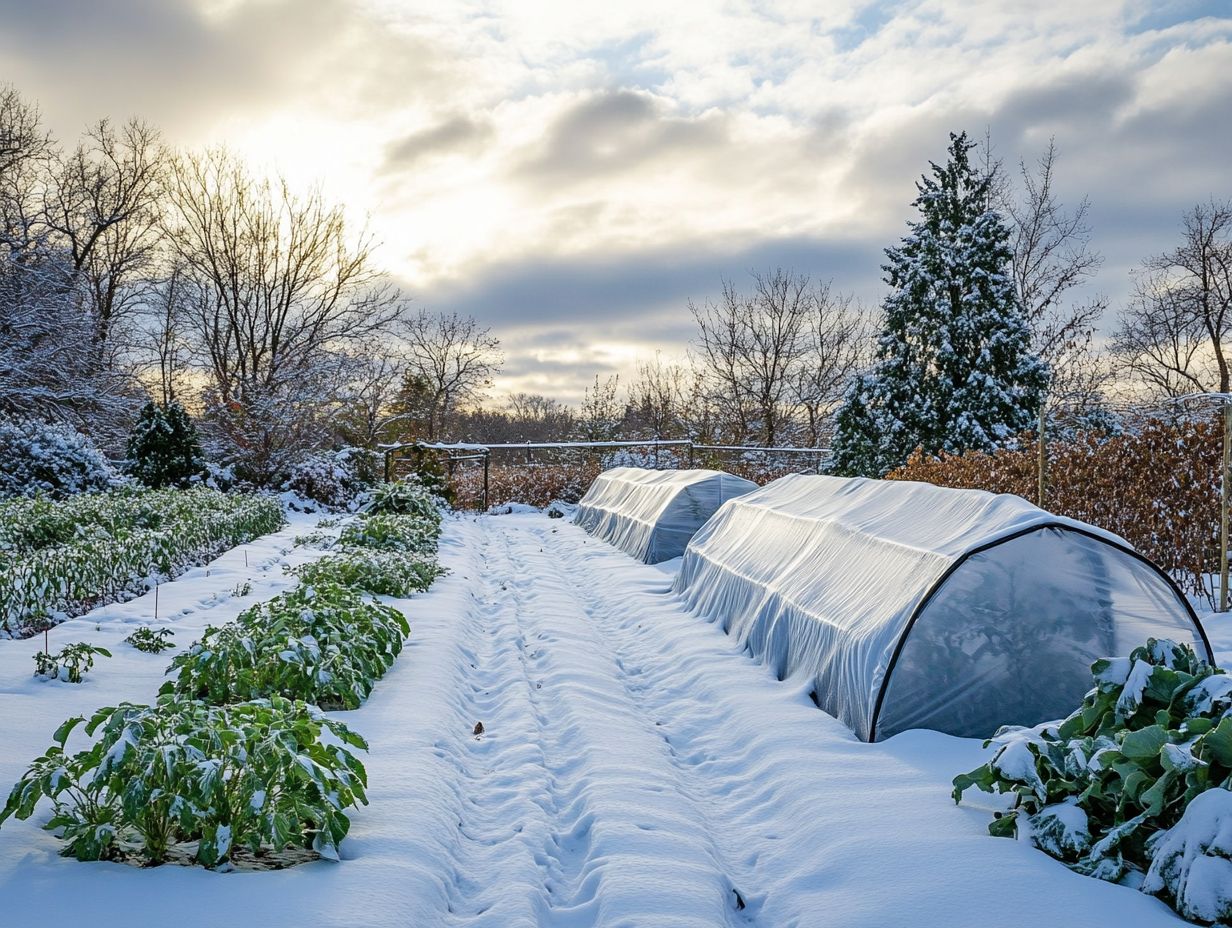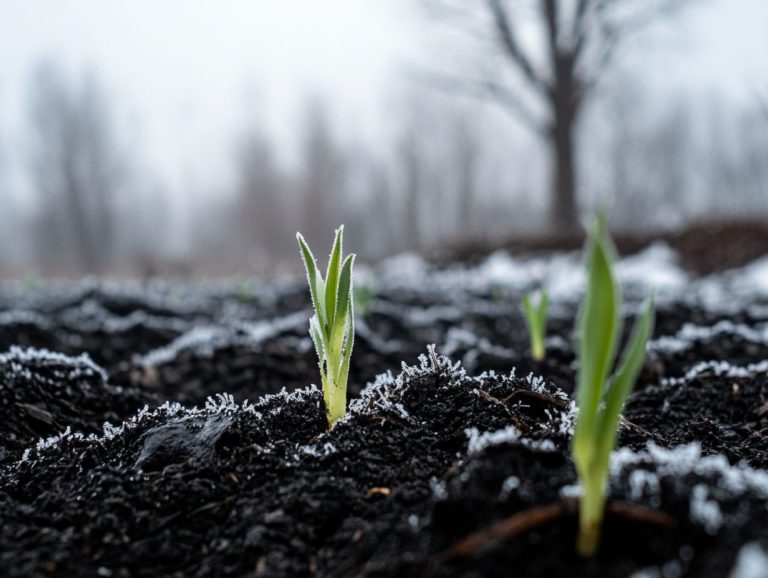Using Row Covers for Winter Protection
As winter draws near, safeguarding your plants becomes essential for maintaining a flourishing garden amidst the changing seasons.
Let s explore the amazing benefits of row covers that will keep your garden thriving! Row covers emerge as a versatile gardening tool, offering protection against chilly temperatures, pesky pests, and eager animals. This article provides insights into the various types available, including floating and permeable options.
You ll also find a comprehensive step-by-step guide on proper installation and maintenance, ensuring your plants thrive throughout the colder months.
Uncover the secrets to maximizing the effectiveness of row covers and keeping your garden vibrant all winter long, providing shelter for your plants against winter weather!
Contents
- Key Takeaways:
- What are Row Covers?
- Benefits of Using Row Covers for Winter Protection
- Types of Row Covers
- How to Use Row Covers for Winter Protection
- Tips for Maximizing the Effectiveness of Row Covers
- Frequently Asked Questions
- What are row covers and why are they used for winter protection?
- When should I start using row covers for winter protection?
- How do I properly use row covers for winter protection?
- What type of row cover should I use for winter protection?
- Can row covers be used for other purposes besides winter protection?
- Do I need to remove row covers during the day for winter protection?
Key Takeaways:

- Row covers provide protection against cold temperatures and pests/animals during winter, leading to healthier and more productive plants while enhancing frost protection.
- There are three types of row covers: floating, lightweight, and heavy-weight. Each has its own benefits and uses.
- To effectively use row covers for winter protection, follow a step-by-step guide and ensure proper installation and maintenance for maximum effectiveness.
What are Row Covers?
Row covers are specialized, lightweight fabrics designed to be an effective ally for gardeners like you. They offer frost protection for a variety of vegetables during the harsh winter months. These covers create a controlled climate around the plants that helps maintain optimal soil temperatures, ensuring healthy growth for your vegetables, such as lettuce, spinach, broccoli, and arugula.
By permitting air and sunlight to filter through while providing a shield against the chill, row covers become critical for nurturing a thriving garden that flourishes through winter and into spring.
Benefits of Using Row Covers for Winter Protection
Utilizing row covers for winter protection presents numerous benefits that can greatly enhance the growth and resilience of your plants during the colder months.
These covers provide vital insulation against frost and facilitate earlier planting. They also extend your harvest season by creating a more favorable environment for your crops.
Protection Against Cold Temperatures
Row covers safeguard against cold temperatures. They act as a barrier, preventing frost from settling on your plants during winter. By maintaining a stable soil temperature, these covers extend your growing period and significantly boost the survival rate of various crops.
When temperatures plunge below 32 F, row covers create a local climate that can elevate temperatures by several degrees, effectively shielding your plants from severe cold stress. For proper installation, simply drape the covers over your plants and secure the edges to trap warmth, ensuring they make direct contact with the soil.
To achieve optimal results, closely monitor weather conditions and adjust your irrigation methods as necessary. Remove the covers on sunny days to prevent overheating while still offering protection against the nighttime chill. By utilizing row covers this way, you can cultivate a more favorable environment for plant growth, extending your growing season even in the harshest climates.
Protection Against Pests and Animals
In addition to providing frost protection, row covers offer an excellent defense against pests and animals that threaten your crops. By creating a physical barrier, these covers effectively deter harmful insects like the Colorado potato beetle and the squash vine borer, while also safeguarding your young plants from larger animals.
They serve as a shield against invasive cabbage moths and aphids, which can wreak havoc on your leafy greens. When you incorporate row covers into your organic gardening strategy, ensure that your plants receive adequate sunlight and airflow. Opting for lightweight fabrics allows for light penetration while keeping those pesky pests at bay, ultimately leading to healthier crops.
Monitoring the conditions beneath the cover is crucial. Periodically lifting the fabric can facilitate pollination, encourage beneficial insects, and help maintain a balanced ecosystem. This balanced ecosystem promotes plant vitality without the need for harmful chemical interventions.
Don’t let your hard work go to waste this winter! Protect your plants now by implementing row covers for the best results.
Types of Row Covers

Row covers are available in an array of types, each carefully designed to fulfill specific purposes in safeguarding your plants from environmental challenges while helping plants grow better.
You ll find three primary categories: lightweight, medium-weight, and heavy-weight row covers. Each variation provides different levels of insulation and pest protection, enabling you to select the ideal option tailored to your unique gardening needs.
Floating Row Covers
Floating row covers are a remarkable innovation in gardening, consisting of lightweight fabric draped directly over your plants. This allows them to thrive unimpeded while still benefiting from essential frost protection. By creating a microclimate, these covers help regulate temperature and moisture levels, promoting healthier growth even in cooler conditions.
Typically crafted from spun-bonded polyester (a special type of lightweight fabric) or polyethylene (another protective fabric), these materials offer insulation and allow sunlight, air, and moisture to reach your plants. When you’re ready to install, simply lay them over the plants and secure with weights or hoops, such as those made from PVC pipe or #9 wire, to keep them firmly in place, even on windy days.
The benefits for your crops are substantial: these covers prevent frost damage, limit pest access, and extend your growing season. For winter gardening, floating row covers adapt seamlessly to shifting weather patterns, shielding your plants from harsh elements while creating an environment that nurtures robust development.
Permeable Row Covers
Permeable row covers are crafted to let air and sunlight filter through while still offering essential insulation and frost protection for your plants. This distinctive feature makes them perfect for creating a balanced environment.
These covers create optimal conditions for crops like kale, spinach, and lettuce, which flourish under gentle warmth and consistent moisture. By promoting healthy airflow, they prevent excess humidity from accumulating, thereby reducing the risk of mold and disease.
Your plants can experience a significant boost in health during winter, as these covers protect delicate crops from chilling temperatures while allowing them to soak up sunlight. Using permeable row covers not only extends your growing season but also enhances flavors and yields, underscoring their invaluable role in winter gardening.
How to Use Row Covers for Winter Protection
Get ready to give your plants the winter protection they need! Utilizing row covers for winter protection demands meticulous planning and execution to guarantee that your plants reap the maximum benefits from these safeguarding measures. It s essential to choose the appropriate type of cover be it lightweight, medium-weight, or heavy-weight and to understand the nuances of installation and maintenance.
By grasping these intricacies, you ll cultivate healthier crops and set the stage for a flourishing growing season.
Step-by-Step Guide
A step-by-step guide to installing row covers for winter protection involves several essential actions to ensure your crops are well-protected and primed for growth. Proper installation is critical to maximizing the effectiveness of the covers in shielding your plants from frost and temperature fluctuations.
- Start by preparing your garden beds: clear away any debris and level the soil to create a smooth surface for the row covers.
- Next, consider the specific needs of your crops to select the most suitable type of cover. Floating row covers work wonders for delicate seedlings, while sturdy plastic tunnels are ideal for larger plants.
Once you’ve chosen the right covers, secure them properly with landscape fabric pins or stones to withstand the wind. Ensure they fit snugly over the plants without making direct contact.
During the colder months, it’s vital to monitor the conditions beneath the covers. Check for moisture buildup and adjust as necessary to prevent mold from becoming a problem. If you encounter common issues like sagging, you can easily resolve them by adding more support or slightly adjusting your installation method.
Start your winter gardening today and give your plants the protection they deserve!
Tips for Maximizing the Effectiveness of Row Covers

To maximize the effectiveness of row covers during winter, follow specific tips and practices, such as using bracing and mulch to enhance their ability to protect your plants from harsh weather conditions.
Proper installation and diligent ongoing maintenance are essential to ensure your row covers remain functional and beneficial throughout the cold months.
Proper Installation and Maintenance
Proper installation and maintenance are key for row covers to provide winter protection, especially in regions with unpredictable cold weather. Securely positioning and regularly checking your covers can prevent issues like sagging and damage, promoting optimal growth under their protective shelter.
Start by choosing the right materials for your row covers. Those specifically designed for winter conditions offer enhanced durability. Installing the covers tightly, using stakes or clamps, helps them withstand harsh winds and heavy snowfall.
Make regular inspections a priority during winter months. Checking for signs of wear or holes ensures your crops receive consistent protection. Clearing snow accumulation or frost can mitigate potential damage, allowing the covers to perform at their best while safeguarding crops from frigid temperatures and harsh weather fluctuations.
Final Thoughts and Recommendations
Using row covers for winter gardening is an effective strategy for safeguarding your crops against frost and cold weather, ensuring a bountiful harvest come spring. With the right techniques, materials, and maintenance, you can successfully cultivate a diverse range of vegetables throughout the winter months.
To maximize the benefits of row covers, choose the right materials, such as lightweight fabric or plastic. These options allow sunlight to penetrate while providing adequate insulation.
Think strategically about installation: securing the covers firmly to the ground helps prevent wind damage, and using hoops creates a stable environment for taller plants.
Regular monitoring is crucial; make it a habit to check moisture levels and potential pest issues beneath the covers to keep your crops healthy. Informed decisions about materials and care significantly enhance your winter gardening success.
Frequently Asked Questions
What are row covers and why are they used for winter protection?
Row covers are lightweight, breathable fabric covers placed over plants to protect them from harsh winter conditions such as freezing temperatures, strong winds, and heavy snow. They help retain heat and moisture, creating a more favorable environment for plants.
When should I start using row covers for winter protection?

The best time to use row covers for winter protection is before the first frost or when temperatures consistently drop below freezing. This ensures your plants are protected before any damage occurs.
How do I properly use row covers for winter protection?
Row covers should be laid over the plants and secured to the ground using stakes or weights. Keep the fabric from touching the plants to avoid damage. Leave enough slack for plant growth, using clips or clothespins to hold the edges of the fabric together.
What type of row cover should I use for winter protection?
There are different types of row covers available, such as heavy-weight or lightweight, depending on the protection needed. Generally, a heavier fabric provides more protection but may restrict sunlight and airflow. Choose a fabric specifically designed for winter protection.
Can row covers be used for other purposes besides winter protection?
Yes! Row covers do more than just protect plants in winter. They guard against insects, birds, and even harsh weather like hail.
Row covers also help extend the growing season. They create a warmer environment that plants love!
Do I need to remove row covers during the day for winter protection?
If temperatures rise above freezing, it’s best to remove the row covers during the day. This allows air to circulate and prevents overheating.
However, if it stays cold, you can leave the covers on all day. Keeping your plants safe is the priority!






